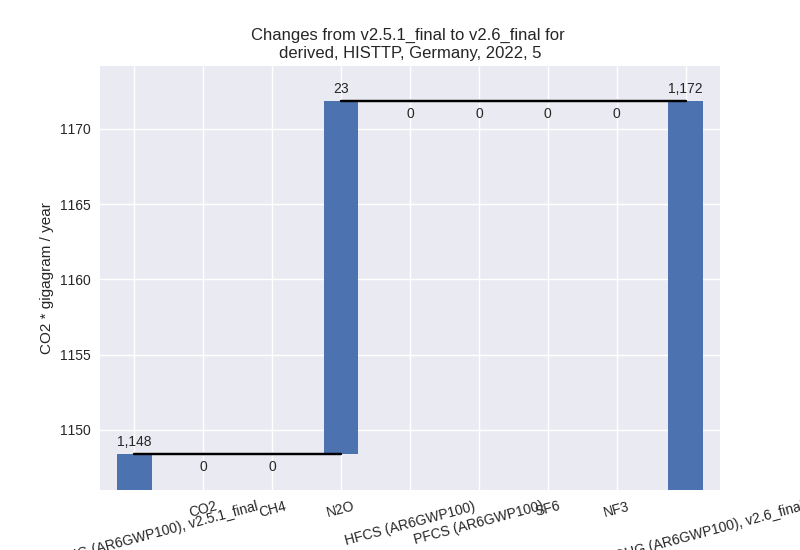Changes in PRIMAP-hist v2.6_final compared to v2.5.1_final for Germany
2024-09-24
Johannes Gütschow
Change analysis for Germany for PRIMAP-hist v2.6_final compared to v2.5.1_final
Overview over emissions by sector and gas
The following figures show the aggregate national total emissions excluding LULUCF AR6GWP100 for the country reported priority scenario. The dotted linesshow the v2.5.1_final data.
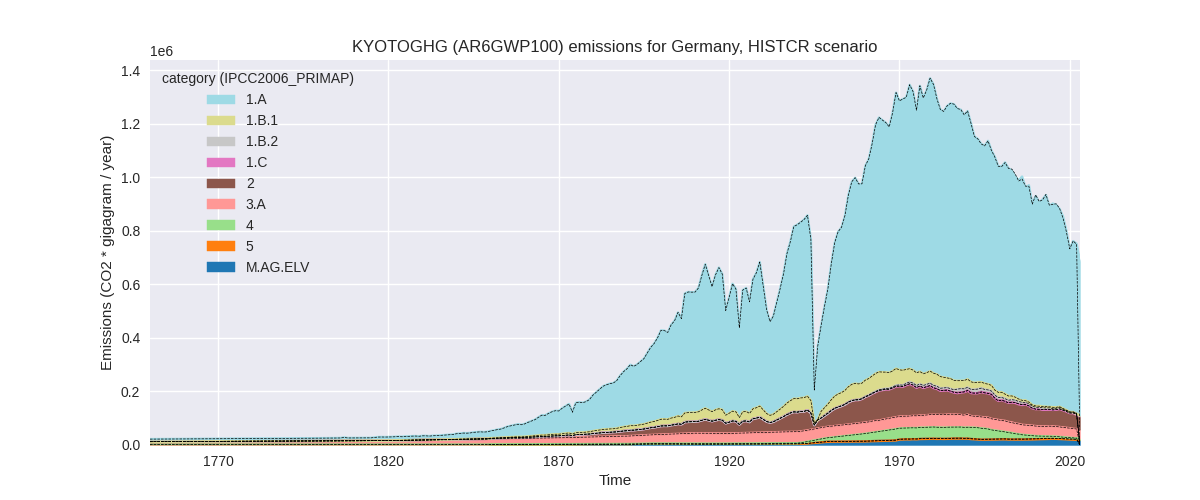
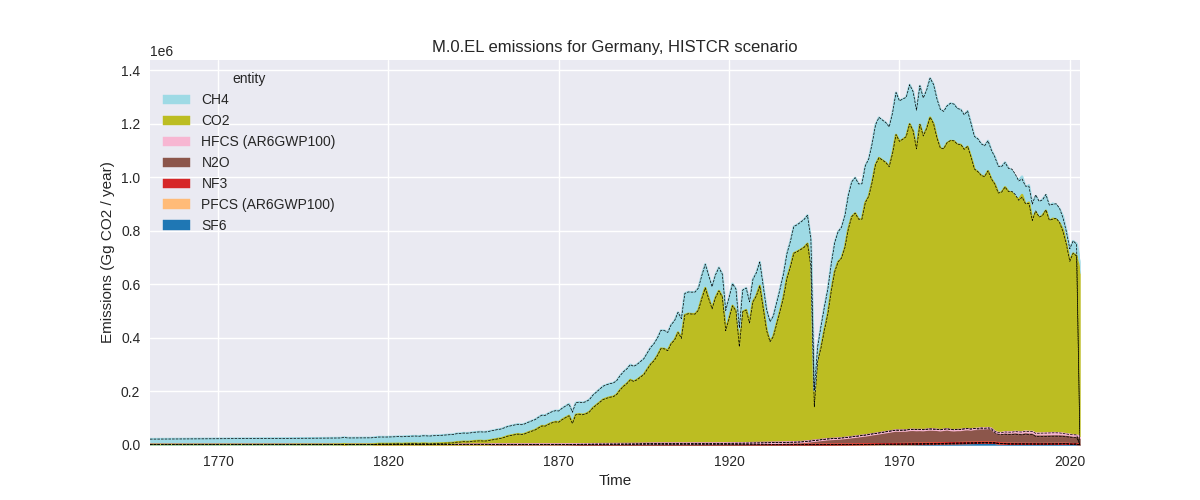
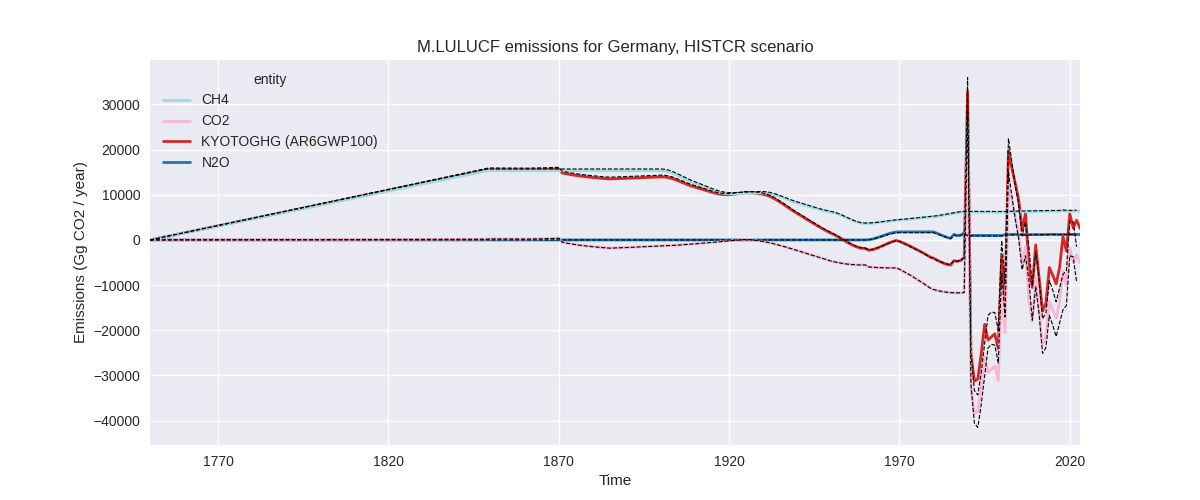
The following figures show the aggregate national total emissions excluding LULUCF AR6GWP100 for the third party priority scenario. The dotted linesshow the v2.5.1_final data.
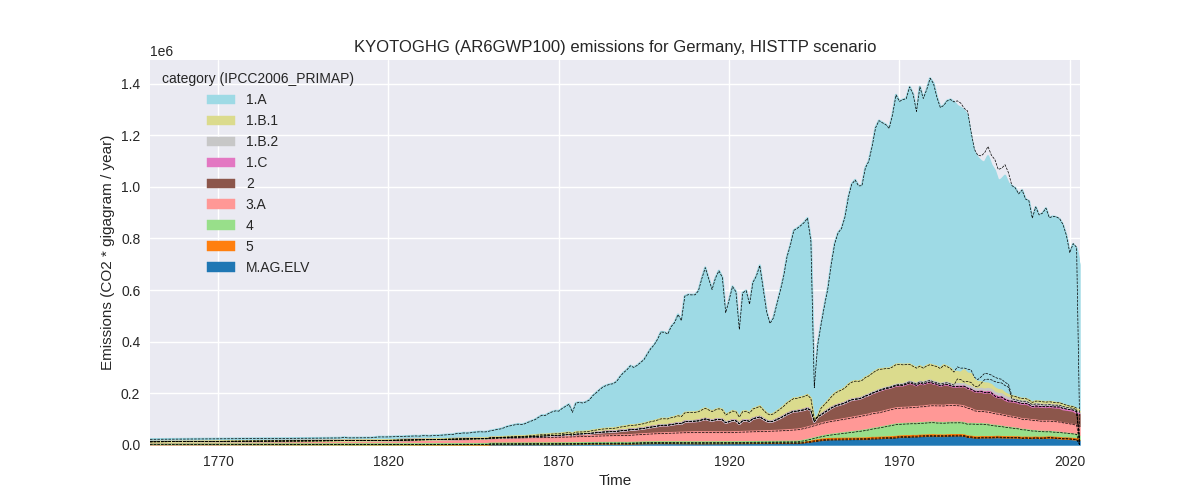
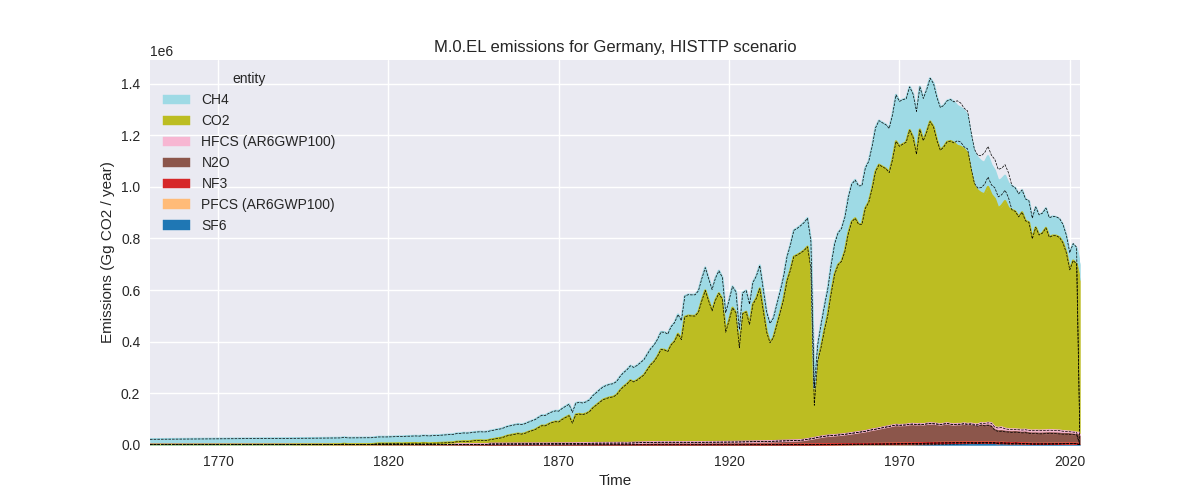
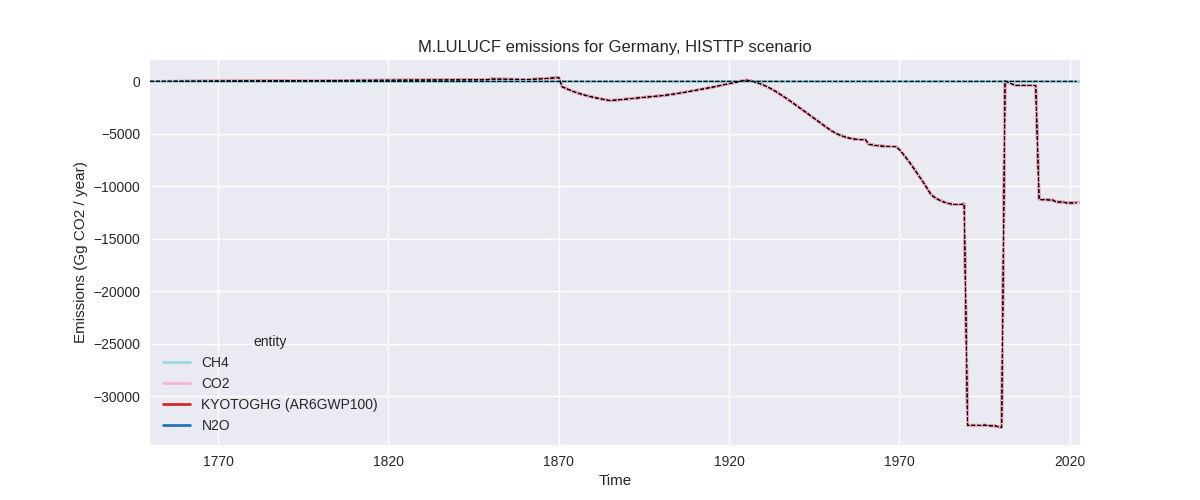
Overview over changes
In the country reported priority scenario we have the following changes for aggregate Kyoto GHG and national total emissions excluding LULUCF (M.0.EL):
- Emissions in 2022 have changed by 0.2%% (1827.41 Gg CO2 / year)
- Emissions in 1990-2022 have changed by -0.0%% (-181.89 Gg CO2 / year)
In the third party priority scenario we have the following changes for aggregate Kyoto GHG and national total emissions excluding LULUCF (M.0.EL):
- Emissions in 2022 have changed by -0.6%% (-4498.18 Gg CO2 / year)
- Emissions in 1990-2022 have changed by -1.4%% (-13357.18 Gg CO2 / year)
Most important changes per scenario and time frame
In the country reported priority scenario the following sector-gas combinations have the highest absolute impact on national total KyotoGHG (AR6GWP100) emissions in 2022 (top 5):
- 1: 1.A, CO2 with 4240.01 Gg CO2 / year (0.7%)
- 2: M.AG.ELV, N2O with -2165.88 Gg CO2 / year (-12.2%)
- 3: 2, SF6 with -1381.32 Gg CO2 / year (-39.1%)
- 4: 4, N2O with 845.45 Gg CO2 / year (140.2%)
- 5: 4, CH4 with 604.35 Gg CO2 / year (16.6%)
In the country reported priority scenario the following sector-gas combinations have the highest absolute impact on national total KyotoGHG (AR6GWP100) emissions in 1990-2022 (top 5):
- 1: M.AG.ELV, N2O with -1580.12 Gg CO2 / year (-8.1%)
- 2: 4, CH4 with 623.46 Gg CO2 / year (3.2%)
- 3: 4, N2O with 563.13 Gg CO2 / year (80.7%)
- 4: 3.A, CH4 with 177.55 Gg CO2 / year (0.5%)
- 5: 1.B.2, CH4 with 124.27 Gg CO2 / year (1.9%)
In the third party priority scenario the following sector-gas combinations have the highest absolute impact on national total KyotoGHG (AR6GWP100) emissions in 2022 (top 5):
- 1: 4, CH4 with -2180.15 Gg CO2 / year (-13.0%)
- 2: 2, SF6 with -1372.05 Gg CO2 / year (-27.9%)
- 3: 1.A, CO2 with -473.56 Gg CO2 / year (-0.1%)
- 4: 2, CO2 with -290.00 Gg CO2 / year (-0.9%)
- 5: 2, PFCS (AR6GWP100) with -143.65 Gg CO2 / year (-16.8%)
In the third party priority scenario the following sector-gas combinations have the highest absolute impact on national total KyotoGHG (AR6GWP100) emissions in 1990-2022 (top 5):
- 1: 1.B.2, CO2 with -12687.73 Gg CO2 / year (-91.6%)
- 2: 4, CH4 with -767.17 Gg CO2 / year (-2.5%)
- 3: 2, SF6 with -41.58 Gg CO2 / year (-0.9%)
- 4: 5, N2O with 17.90 Gg CO2 / year (0.8%)
- 5: 1.A, CO2 with -11.41 Gg CO2 / year (-0.0%)
Notes on data changes
Here we list notes explaining important emissions changes for the country. ’' means that the following text only applies to the TP time series, while means that it only applies to the CR scenario. Otherwise the note applies to both scenarios.
- We have added EEA 2024 inventory data
- 2022 and cumulative emissions in the CR scenario are lower for N2O from agriculture excluding livestock because EEA 2024 emissions are lower than CRF2023
- Waste N2O emissions are much higher in 2022 and cumulatively in the CR scenario due to changes in EEA 2024 vs CRF2023.
- Much lower SF6 emissions in 2022 (CR, TP) are due to recent emissions decline not fully picked up by the extrapolation used in v2.5.1.
- We fixed a scaling issue with CO2 in 1.B.2. emissions from 1986 to 2002 are now more in line with emissions from EDGAR (TP)
Changes by sector and gas
For each scenario and time frame the changes are displayed for all individual sectors and all individual gases. In the sector plot we use aggregate Kyoto GHGs in AR6GWP100. In the gas plot we usenational total emissions without LULUCF. ## country reported scenario
2022
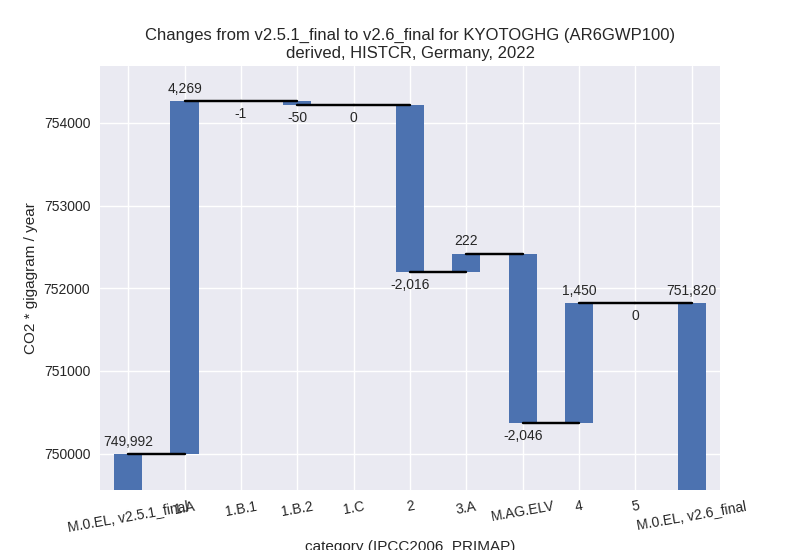
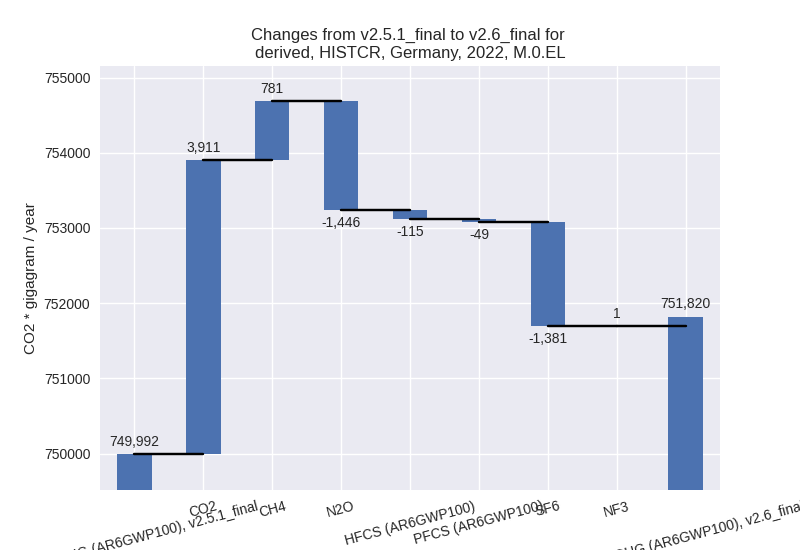
1990-2022
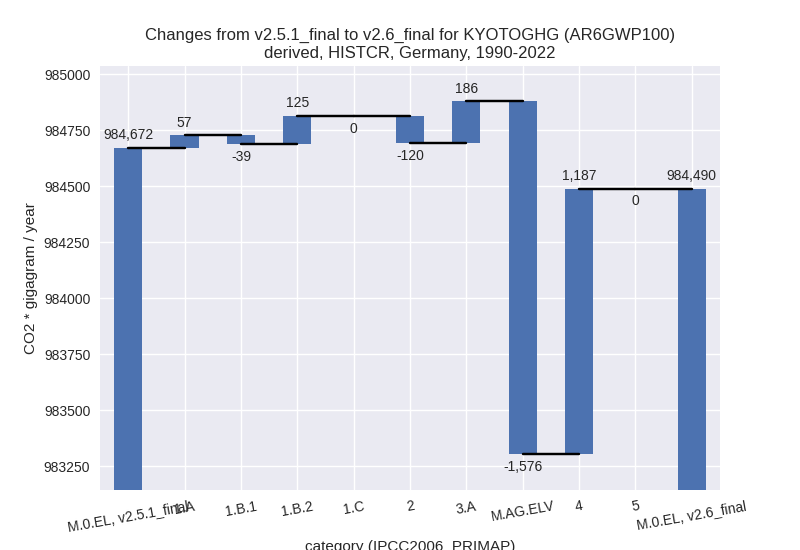
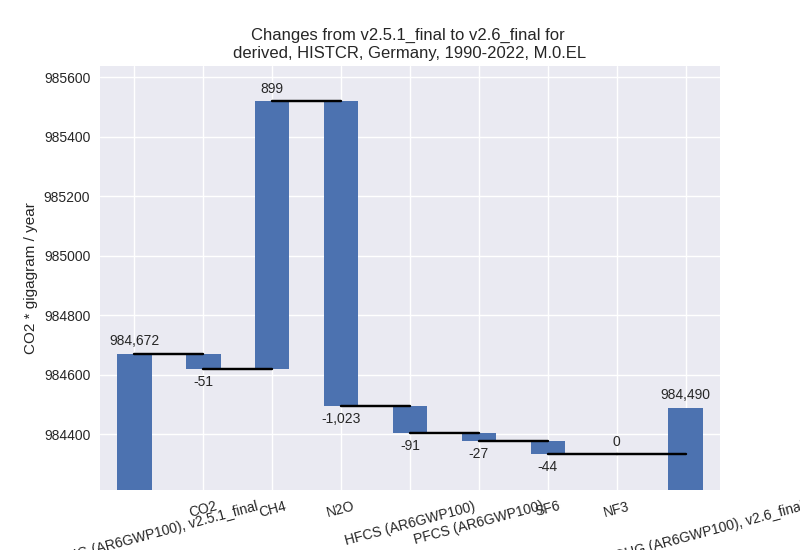
third party scenario
2022
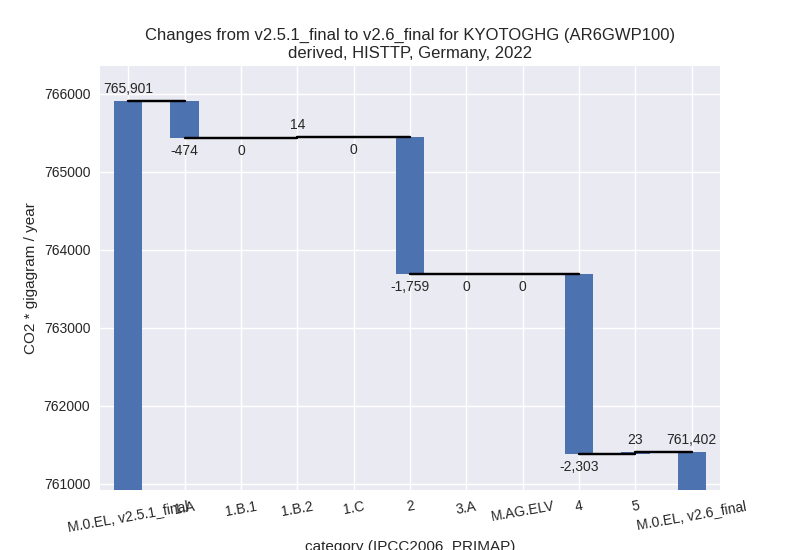

1990-2022
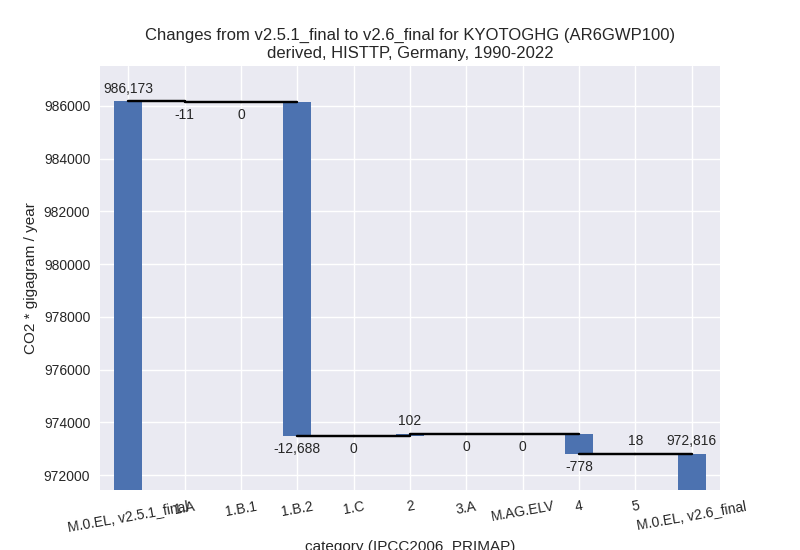
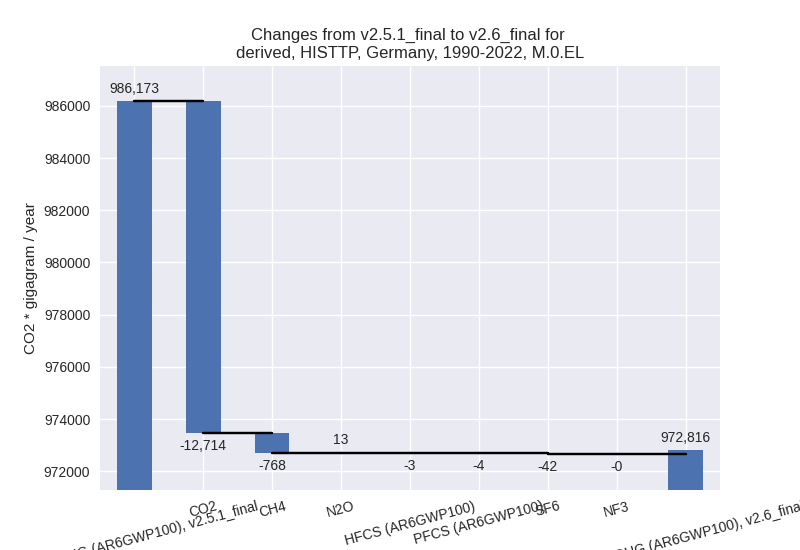
Detailed changes for the scenarios:
country reported scenario (HISTCR):
Most important changes per time frame
For 2022 the following sector-gas combinations have the highest absolute impact on national total KyotoGHG (AR6GWP100) emissions in 2022 (top 5):
- 1: 1.A, CO2 with 4240.01 Gg CO2 / year (0.7%)
- 2: M.AG.ELV, N2O with -2165.88 Gg CO2 / year (-12.2%)
- 3: 2, SF6 with -1381.32 Gg CO2 / year (-39.1%)
- 4: 4, N2O with 845.45 Gg CO2 / year (140.2%)
- 5: 4, CH4 with 604.35 Gg CO2 / year (16.6%)
For 1990-2022 the following sector-gas combinations have the highest absolute impact on national total KyotoGHG (AR6GWP100) emissions in 1990-2022 (top 5):
- 1: M.AG.ELV, N2O with -1580.12 Gg CO2 / year (-8.1%)
- 2: 4, CH4 with 623.46 Gg CO2 / year (3.2%)
- 3: 4, N2O with 563.13 Gg CO2 / year (80.7%)
- 4: 3.A, CH4 with 177.55 Gg CO2 / year (0.5%)
- 5: 1.B.2, CH4 with 124.27 Gg CO2 / year (1.9%)
Changes in the main sectors for aggregate KyotoGHG (AR6GWP100) are
- 1: Total sectoral emissions in 2022 are 639001.57 Gg CO2 / year which is 85.0% of M.0.EL emissions. 2022 Emissions have changed by 0.7% (4218.36 Gg CO2 / year). 1990-2022 Emissions have changed by 0.0% (142.25 Gg CO2 / year).
- 2: Total sectoral emissions in 2022 are 53399.89 Gg
CO2 / year which is 7.1% of M.0.EL emissions. 2022 Emissions have
changed by -3.6% (-2016.38 Gg CO2 /
year). 1990-2022 Emissions have changed by -0.2% (-120.41 Gg CO2 / year). For 2022
the changes per gas
are:
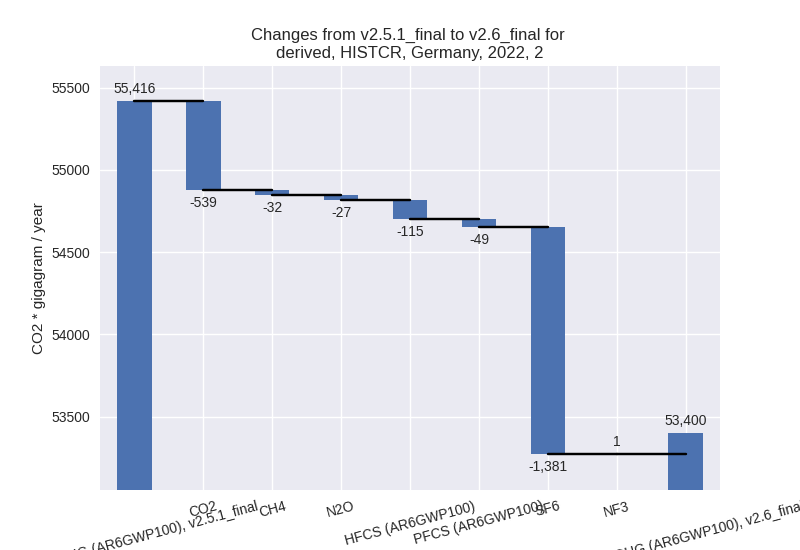
- M.AG: Total sectoral emissions in 2022 are 53730.48
Gg CO2 / year which is 7.1% of M.0.EL emissions. 2022 Emissions have
changed by -3.3% (-1824.36 Gg CO2 /
year). 1990-2022 Emissions have changed by -2.3% (-1390.32 Gg CO2 / year). For 2022
the changes per gas
are:
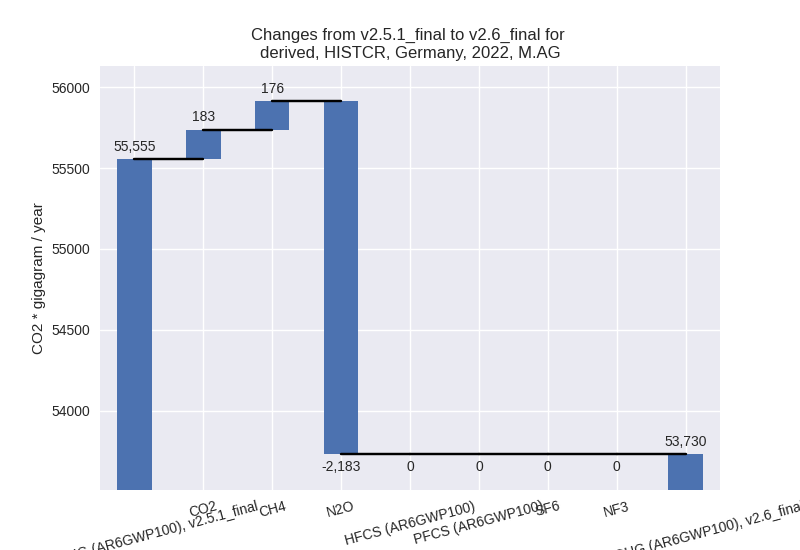
For 1990-2022 the changes per gas are: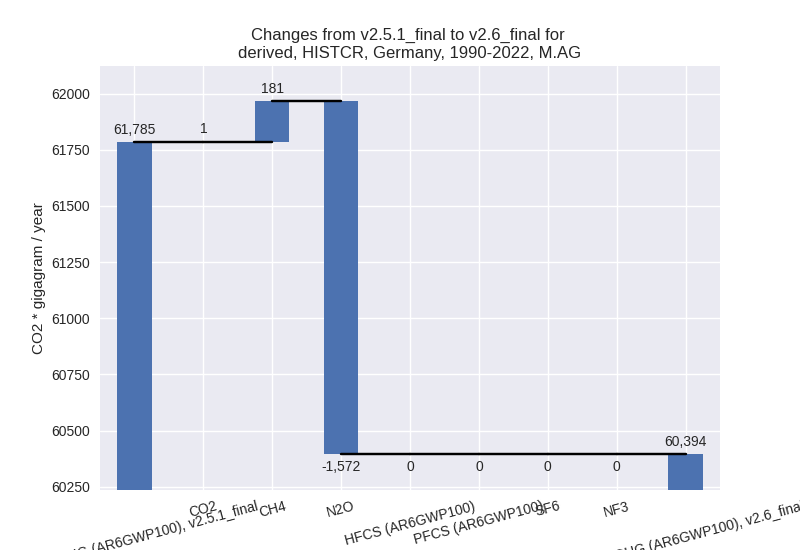
The changes come from the following subsectors:- 3.A: Total sectoral emissions in 2022 are 34211.36 Gg CO2 / year which is 63.7% of category M.AG emissions. 2022 Emissions have changed by 0.7% (221.96 Gg CO2 / year). 1990-2022 Emissions have changed by 0.5% (185.77 Gg CO2 / year).
- M.AG.ELV: Total sectoral emissions in 2022 are
19519.12 Gg CO2 / year which is 36.3% of category M.AG emissions. 2022
Emissions have changed by -9.5%
(-2046.32 Gg CO2 / year). 1990-2022 Emissions have changed by -6.9% (-1576.10 Gg CO2 / year). For 2022
the changes per gas
are:
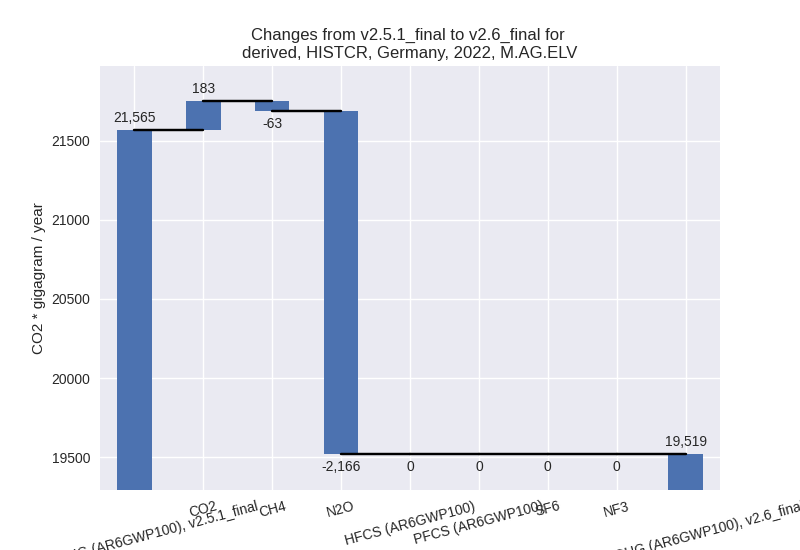
For 1990-2022 the changes per gas are: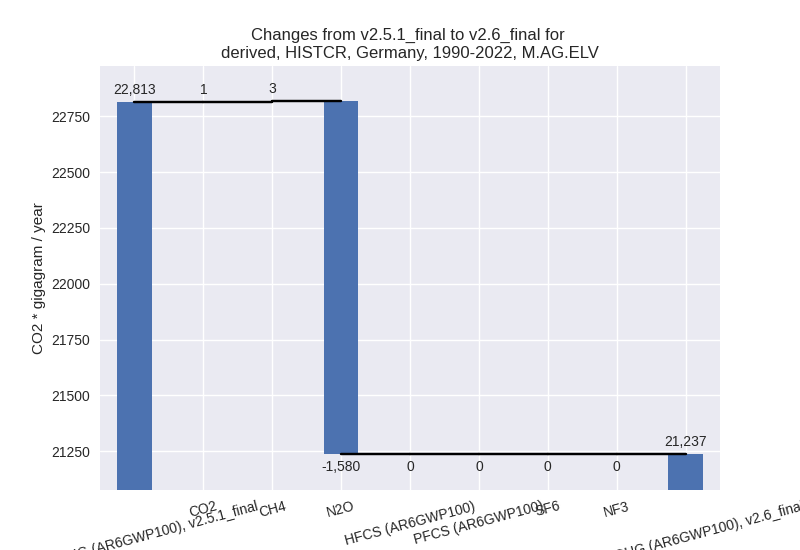
There is no subsector information available in PRIMAP-hist.
- 4: Total sectoral emissions in 2022 are 5687.67 Gg
CO2 / year which is 0.8% of M.0.EL emissions. 2022 Emissions have
changed by 34.2% (1449.80 Gg CO2 /
year). 1990-2022 Emissions have changed by 5.8% (1186.60 Gg CO2 / year). For 2022 the
changes per gas
are:
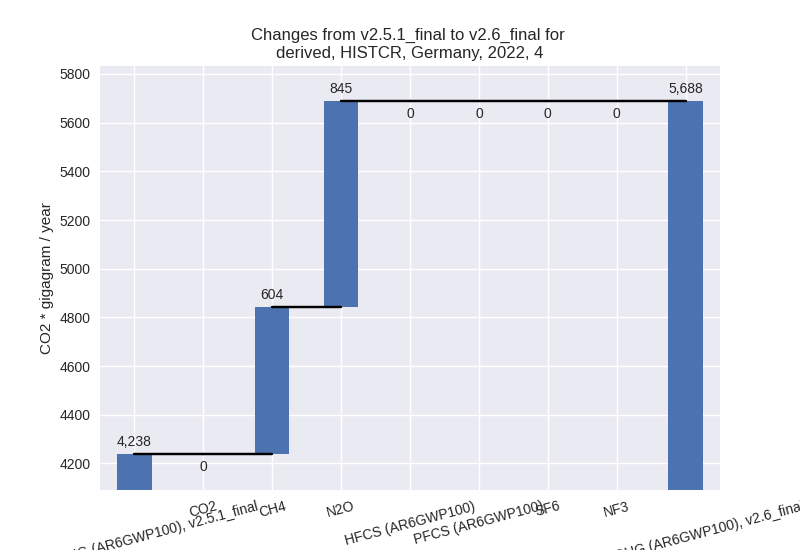
For 1990-2022 the changes per gas are: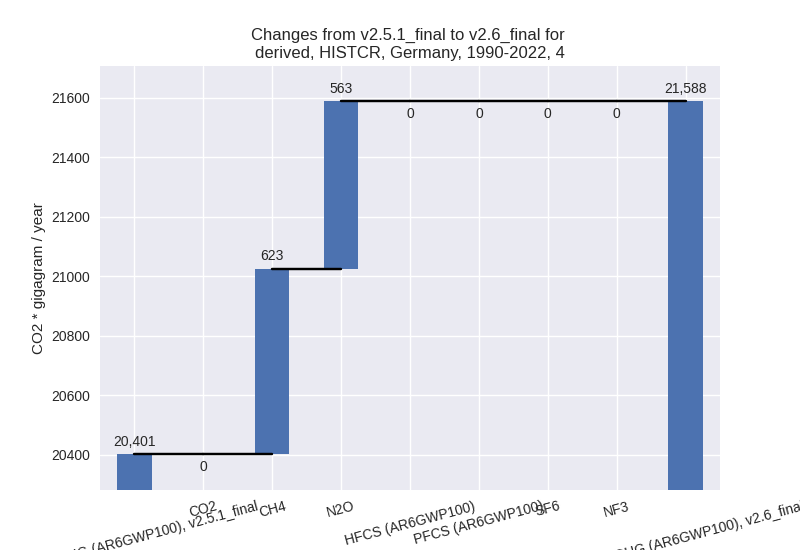
- 5: No data
third party scenario (HISTTP):
Most important changes per time frame
For 2022 the following sector-gas combinations have the highest absolute impact on national total KyotoGHG (AR6GWP100) emissions in 2022 (top 5):
- 1: 4, CH4 with -2180.15 Gg CO2 / year (-13.0%)
- 2: 2, SF6 with -1372.05 Gg CO2 / year (-27.9%)
- 3: 1.A, CO2 with -473.56 Gg CO2 / year (-0.1%)
- 4: 2, CO2 with -290.00 Gg CO2 / year (-0.9%)
- 5: 2, PFCS (AR6GWP100) with -143.65 Gg CO2 / year (-16.8%)
For 1990-2022 the following sector-gas combinations have the highest absolute impact on national total KyotoGHG (AR6GWP100) emissions in 1990-2022 (top 5):
- 1: 1.B.2, CO2 with -12687.73 Gg CO2 / year (-91.6%)
- 2: 4, CH4 with -767.17 Gg CO2 / year (-2.5%)
- 3: 2, SF6 with -41.58 Gg CO2 / year (-0.9%)
- 4: 5, N2O with 17.90 Gg CO2 / year (0.8%)
- 5: 1.A, CO2 with -11.41 Gg CO2 / year (-0.0%)
Changes in the main sectors for aggregate KyotoGHG (AR6GWP100) are
- 1: Total sectoral emissions in 2022 are 636386.10 Gg CO2 / year which is 83.6% of M.0.EL emissions. 2022 Emissions have changed by -0.1% (-459.09 Gg CO2 / year). 1990-2022 Emissions have changed by -1.6% (-12699.14 Gg CO2 / year).
- 2: Total sectoral emissions in 2022 are 50542.23 Gg
CO2 / year which is 6.6% of M.0.EL emissions. 2022 Emissions have
changed by -3.4% (-1759.40 Gg CO2 /
year). 1990-2022 Emissions have changed by 0.2% (101.95 Gg CO2 / year). For 2022 the
changes per gas
are:
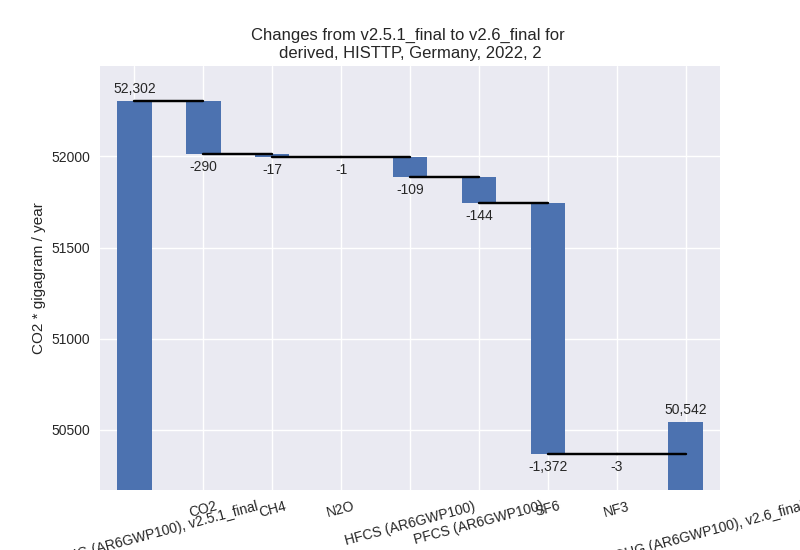
- M.AG: Total sectoral emissions in 2022 are 56458.73 Gg CO2 / year which is 7.4% of M.0.EL emissions. 2022 Emissions have changed by 0.0% (0.00 Gg CO2 / year). 1990-2022 Emissions have changed by 0.0% (0.00 Gg CO2 / year).
- 4: Total sectoral emissions in 2022 are 16843.50 Gg
CO2 / year which is 2.2% of M.0.EL emissions. 2022 Emissions have
changed by -12.0% (-2303.13 Gg CO2 /
year). 1990-2022 Emissions have changed by -2.3% (-777.88 Gg CO2 / year). For 2022
the changes per gas
are:
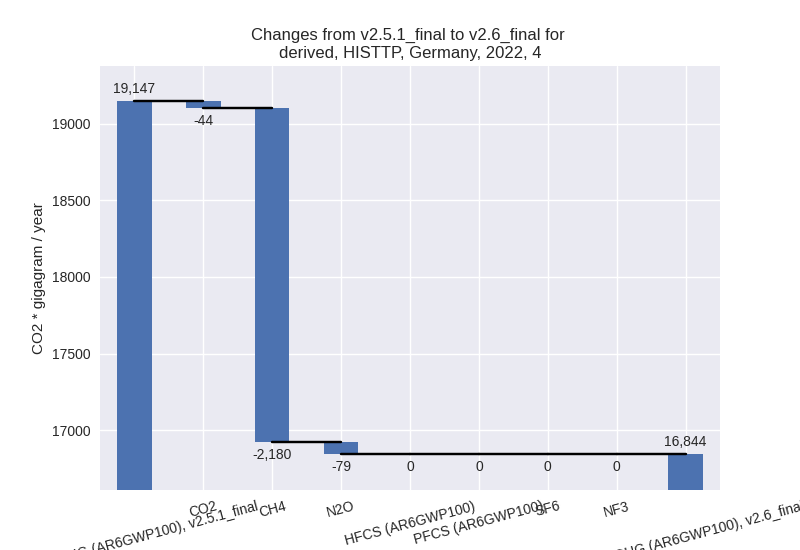
For 1990-2022 the changes per gas are: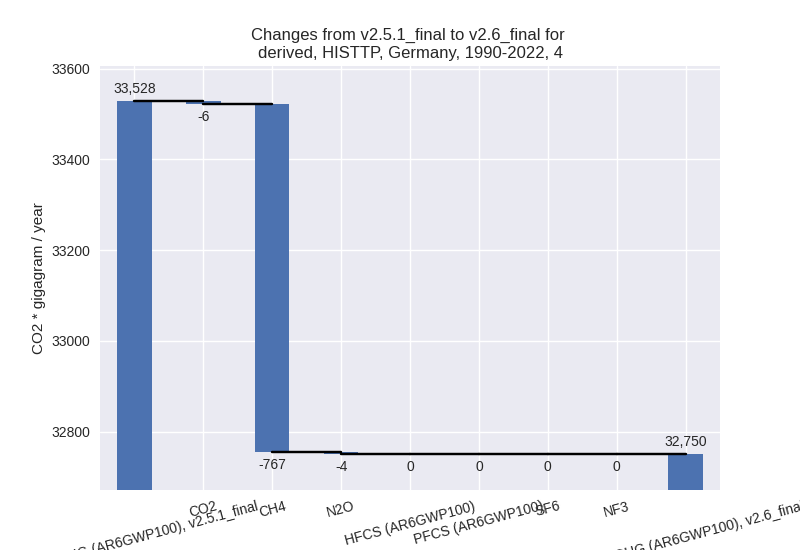
- 5: Total sectoral emissions in 2022 are 1171.82 Gg
CO2 / year which is 0.2% of M.0.EL emissions. 2022 Emissions have
changed by 2.0% (23.44 Gg CO2 /
year). 1990-2022 Emissions have changed by 0.8% (17.90 Gg CO2 / year). For 2022 the
changes per gas
are:
